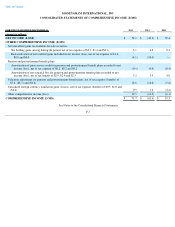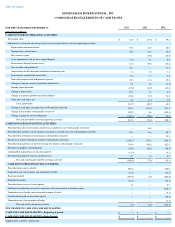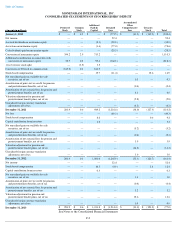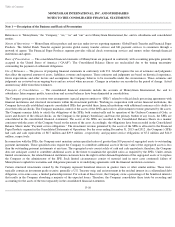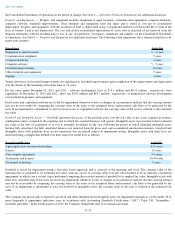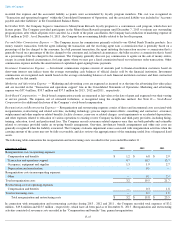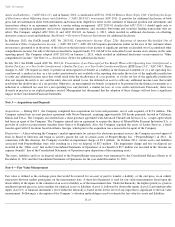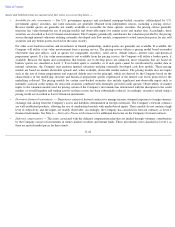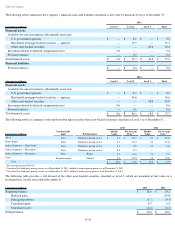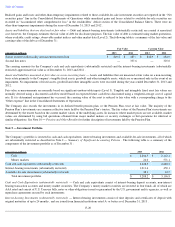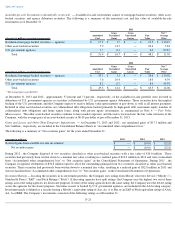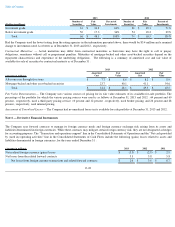MoneyGram 2013 Annual Report Download - page 82
Download and view the complete annual report
Please find page 82 of the 2013 MoneyGram annual report below. You can navigate through the pages in the report by either clicking on the pages listed below, or by using the keyword search tool below to find specific information within the annual report.
Table of Contents
of goodwill to October 1 of each year. The change in testing date for goodwill is a change in accounting principle, which management believes is
preferable as the new date of the assessment, while remaining in the fourth quarter, will create a more efficient and timely process surrounding
the impairment tests and better align with the Company’
s annual planning and budgeting process. The change in the assessment date does not
delay, accelerate or avoid a potential impairment charge. The Company has determined that it is impracticable to objectively determine projected
cash flows and related valuation estimates that would have been used as of each October 1 of prior reporting periods without the use of
hindsight. As such, the Company prospectively applied the change in annual goodwill impairment testing date from October 1, 2013. No
impairment was recognized as a result of the October 1, 2013 testing.
Payments on Long
-Term Contracts —
The Company makes payments to certain agents and financial institution customers as an incentive to
enter into long-
term contracts. The payments, or signing bonuses, are generally required to be refunded pro rata in the event of nonperformance
under, or cancellation of, the contract by the customer. All signing bonuses are capitalized and amortized over the life of the related contract.
Amortization of signing bonuses on long-term contracts is recorded in “Fee and other commissions expense”
in the Consolidated Statements of
Operations. The carrying values of the signing bonuses are reviewed annually or whenever events or changes in circumstances indicate that the
carrying amounts may not be recoverable.
Income Taxes
— The provision for income taxes is computed based on the pre-
tax income (loss) included in the Consolidated Statements of
Operations. Deferred tax assets and liabilities are recorded based on the future tax consequences attributable to temporary differences that exist
between the financial statement carrying value of assets and liabilities and their respective tax basis, and operating loss and tax credit carry-
backs
and carry-
forwards on a taxing jurisdiction basis. The Company measures deferred tax assets and liabilities using enacted statutory tax rates that
will apply in the years in which the Company expects the temporary differences to be recovered or paid. The Company's ability to realize
deferred tax assets depends on the ability to generate sufficient taxable income within the carry-back or carry-
forward periods provided for in the
tax law. The Company established valuation allowances for the Company's deferred tax assets based on a more-likely-than-
not threshold. To the
extent management believes that recovery is not likely, a valuation allowance is established in the period in which the determination is made.
The liability for unrecognized tax benefits is recorded as a non-cash item in “Accounts payable and other liabilities”
in the Consolidated Balance
Sheets. The Company records interest and penalties for unrecognized tax benefits in “Income tax expense (benefit)”
in the Consolidated
Statements of Operations. See Note 13 — Income Taxes for additional disclosure.
Treasury Stock — Repurchased common stock is stated at cost and is presented as a separate component of stockholders’
deficit. See
Note 11
— Stockholders’ Deficit for additional disclosure.
Foreign Currency Translation
—
The Company converts assets and liabilities of foreign operations to their U.S. dollar equivalents at rates in
effect at the balance sheet dates, recording the translation adjustments in “Accumulated other comprehensive loss”
in the Consolidated Balance
Sheets. Income statements of foreign operations are translated from the operation’
s functional currency to U.S. dollar equivalents at the average
exchange rate for the month. Foreign currency exchange transaction gains and losses are reported in “Transaction and operations support”
in the
Consolidated Statements of Operations.
Revenue Recognition
—
The Company derives revenue primarily through service fees charged to consumers and through its investing activity.
A description of these revenues and revenue recognition policies is as follows:
Customer Loyalty Program —
The MoneyGram Rewards loyalty program, introduced in January 2012, allowed enrolled members to earn
points based on the face value of their send transactions, along with opportunities for points earned from promotional activities. Points were
redeemable for various denominations of gift cards. The Company estimated the cost of the rewards and
F-14
•
Fee and other revenue consists of transaction fees, service revenue, foreign exchange revenue and other revenue.
•
Transaction fees consist primarily of fees earned on money transfer, money order, bill payment and official check transactions.
The money transfer transaction fees vary based on the principal value of the transaction and the locations in which these
money transfers originate and to which they are sent. The official check, money order and bill payment transaction fees are
fixed fees charged on a per item basis. Transaction fees are recognized at the time of the transaction or sale of the product.
•
Service revenue primarily consists of service charges on aged outstanding money orders and money order dispenser fees.
•
Foreign exchange revenue is derived from the management of currency exchange spreads on money transfer transactions
involving different “send” and “receive”
currencies. Foreign exchange revenue is recognized at the time the exchange in funds
occurs.
•
Investment revenue is derived from the investment of funds generated from the sale of payment instruments, primarily official checks
and money orders, and consists of interest income, dividend income, income received on our cost recovery securities and amortization
of premiums and discounts.




